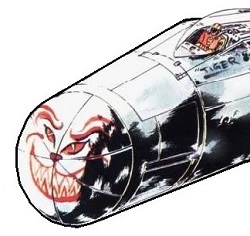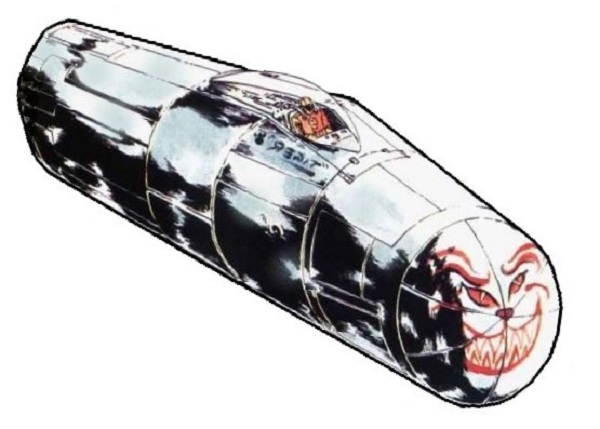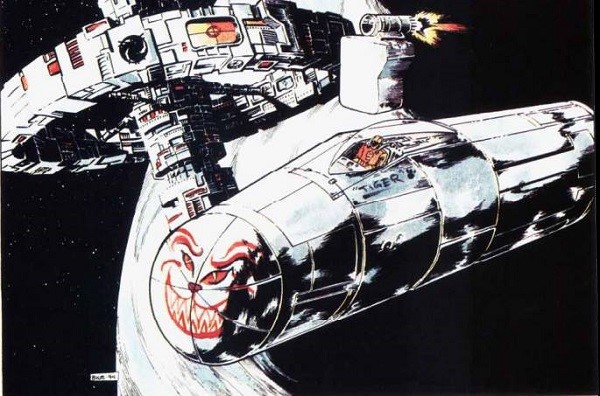Foxbat class Pathfinder
| Foxbat class Pathfinder | |
|---|---|
 The brilliantly decorated nose art on the sensor socket of a Wildbat class Fighter. | |
| Type: UQ Pathfinder | |
| Category | Smallcraft |
| Size | 16 Tons |
| Hull Configuration | Cylinder Hull |
| Streamlining | Streamlined Hull |
| Tech Level | TL–12 |
| Engineering | |
| Computer | Model/1 Flt |
| Jump | J-0 |
| Maneuver | 3 G |
| Armaments | |
| Hardpoints | 1 |
| Accommodations | |
| Staterooms | 0 |
| Personnel | |
| Crew | 2 |
| Officers | 1 |
| Enlisted | 1 |
| High/Mid Passengers | 0 |
| Payload | |
| Cargo | 0.1 Tons |
| Fuel tank | 0 Tons |
| Construction | |
| Origin | Third Imperium |
| Year Operational | Unknown |
| End of Service | Still in active service. |
| Price | |
| Cost | MCr15.5 |
| Architect fee | MCrDave Nilsen |
| Statistics | |
| Quick Ship Profile | UQ-2S30 |
| Images | |
| Blueprint | No |
| Illustration | Yes |
| Source | |
| Also see | Combat Support Ship - Utility Craft |
| Canon | Published, fan design |
| Era | 1105 |
| Reference | Reformation Coalition Equipment Guide 148. |
| Starships are designed with the Classic Traveller format, using High Guard. | |
The Foxbat class Pathfinder is a combatant smallcraft.
- It is a military ship and a Pathfinder.
Description (Specifications)[edit]
Wildbats are capable of refueling while in flight, either from other Wildbats, or from other vessels (a tanker has been specially designed for this purpose).
Basic life support and AG compensation provided only for the crew compartment workstation and the turret workstation, although the turret workstation is normally occupied only when the socket sensor pod is fitted. Wildbat pilots normally wear vac suits, and most bring personal reentry kits and other equipment (stowed in the cargo cabinet adjacent to the cockpit). No additional provision is made for personal equipment for the second crewmember, and they must split the space available with the pilot.
When equipped with the turret sensor package (noted below in the “ Socket Sensor Package”) instead of a laser turret, this craft is known as the Foxbat class Pathfinder.
The fuselage hardpoint is provided for use in tactical support missions to a planetary surface. If loaded to more than 820 kg, this will reduce the craft to 1G acceleration unless fuel tonnage is likewise reduced, with appropriate deductions from the fighter’s operating time. For example, the Wildbat could carry 2000 kg on the fuselage hardpoint without a G penalty by reducing its total fuel by 1780 kg (16.86 m3), a loss of 17 G-turns.
Image Repository[edit]
- A Wildbat class Fighter under spaceflight.

- A Wildbat class Fighter performing combat aero patrol by a space station.

General Description & Deck Plans[edit]
Other Turret Sockets: Because the Wildbat only provides 3.3 MW to the turret socket, socket lasers that normally draw greater power than this have their performance reduced when fitted to the Wildbat. Widbat performance is shown below. Note that some lasers are limited to less than this by their focal arrays and leave part of the 3.3 MW power supply unused. The Mj listed under Description is the power for which the'lasers are designed, however all socket lasers installed in the Wiidbat function at no higher than 120-Mj. The value given under MW below shows the true power value at which they operate when installed in the Wildbat.
- Note that the TL-13 150-Mj turret will cause the Wildbat to become overloaded, and reduce its acceleration to 1G.
Socket Sensor Package: The socket sensor package was designed to fit into a standard 3-ton socket, and provide ships with an improved sensor without overburdening their power-generation capabilities. Sensor packages such as this are used in Foxbat Pathfinders and are occasionally loaned to merchant vessels operating in cooperation with the RCES, RCN, or planetary governments.
- The package combines both active and passive EMS antenna arrays, to conserve surface area, and contains a 240,000-km active EMS unit, a 60,000-km TL-12 passive EMS unit, a 24 MW fusion power plant with 1 year of fuel, and a workstation for the electronics technician. Because they share an antenna, onlyone EMS unit can be used at a time, This module, although it fits in a standard 3-ton socket, requires 20 m2 of surface area because of the diameter of the PEMS antenna.
Sensors: Passive EMS 60,000 km (2 hexes, 0.06 MW), Active EMS 240,000 km (8 hexes, 24 MW).
- TL: 12; Mass: 59.352 tonnes; Volume: 42 kl; Price: MCr13.3
Basic Ship Characteristics[edit]
Following the Imperial Navy and IISS Universal Ship Profile and data, additional information is presented in the format shown here. The small craft factor indicates the number of squadrons (...of ten subcraft) carried on the ship. Tonnage on the universal ship profile is shown in kilotons (...thousands of tons) where necessary. [1]
| Basic Ship Characteristics [2] | ||
|---|---|---|
| No. | Category | Remarks |
| 1. | Tonnage / Hull | TBD tons. |
| 2. | Crew | xTBD crew. |
| 3. | Performance / Engineering | Propulsion:
|
| 4. | Main Section / Electronics | Model/TBD fib ship computer. |
| 5. | Hardpoints | xTBD hardpoints. |
| 6. | Armament / Weaponry | The normal weapons fit-out for it is:
|
| 7. | Defenses | Defensive Equipment:
|
| 8. | Craft / Drones | None |
| 9. | Fuel Treatment | Fueling Equipment:
|
| 10. | Cost | MCrTBD. |
| 11. | Construction Time | TBD months to build, TBD months in quantity. |
| 12. | Remarks | Other Equipment:
|
History & Background (Dossier)[edit]
No information yet available.
Class Naming Practice/s & Peculiarities[edit]
Vessel Peculiarities: No information yet available.
Class Naming Practice/s: No information yet available.
Selected Variant Types & Classes[edit]
References & Contributors (Sources)[edit]
| This article has metadata. |
| This article is missing content for one or more detailed sections. Additional details are required to complete the article. You can help the Traveller Wiki by expanding it. |
- Marc Miller, Frank Chadwick, John Harshman. High Guard (Game Designers Workshop, 1980), 20-37. (Design Sequence Used)
- Dave Nilsen. Reformation Coalition Equipment Guide (Game Designers Workshop, 1994), 148.
- Traveller Wiki Editorial Team
- Author & Contributor: Lord (Marquis) and Master of Sophontology Maksim-Smelchak of the Ministry of Science
- ↑ Timothy B. Brown. Fighting Ships (Game Designers Workshop, 1981), 10.
- ↑ Timothy B. Brown. Fighting Ships (Game Designers Workshop, 1981), 10.